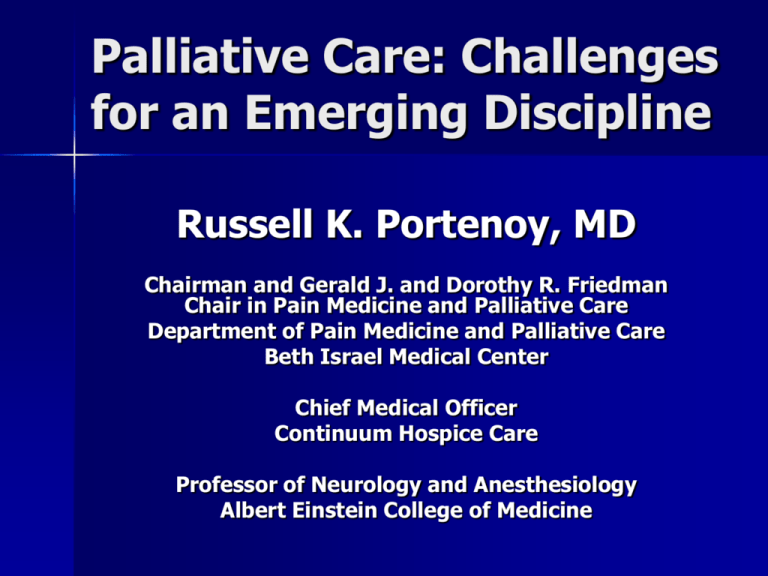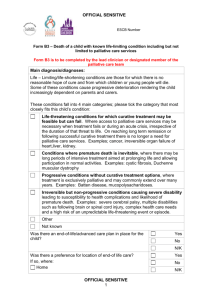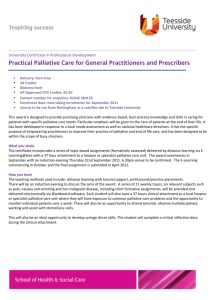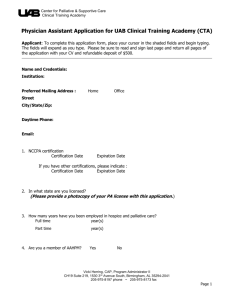Palliative Care - Hospital Association of Southern California
advertisement

Palliative Care: Challenges for an Emerging Discipline Russell K. Portenoy, MD Chairman and Gerald J. and Dorothy R. Friedman Chair in Pain Medicine and Palliative Care Department of Pain Medicine and Palliative Care Beth Israel Medical Center Chief Medical Officer Continuum Hospice Care Professor of Neurology and Anesthesiology Albert Einstein College of Medicine Palliative Care: Challenges for an Emerging Discipline Current landscape Challenges – For the subspecialty – For hospital-based palliative care – For hospice Quality-of-Life Concerns in Cancer Populations High prevalence of poorly controlled symptoms High prevalence of psychological distress High caregiver burden and financial stress Disparities in access and outcomes Health care systems skewed for treatment and acute medical management End-of-Life Care: Illustrative Outcome Data Study: Telephone survey of family members representing 1578 decedents Results: – About 1/4 reported concerns with physician communication – About 1/4 with pain or dyspnea did not receive adequate treatment – Insufficient emotional support reported by 1/3 of those cared for by a home health agency, nursing home, or hospital, and 1/5 receiving home hospice – “Treated with respect”: nursing homes 68.2%, hospitals 79.6%, Home hospice 96.2% – Family satisfaction “excellent”: 50% of those in institutions, 70.7% receiving hospice Teno et al, JAMA, 2004 Intensity and Cost of Treatment for Advanced Cancer: US Trends Study: Analysis of 1993-1996 Medicare claims data from 28,777 patients who died within 1 year of a diagnosis of lung, breast, colorectal, or other gastrointestinal cancer Results: – – – Chemo within 2 weeks of death increased from 13.8% in 1993 to 18.5% in 1996 (P <.001) There were small but significant increases in ED visits, hospitalizations, and ICU admissions in the last month of life Very short hospice admissions (3 days or less) increased from 14.3% to 17.0% (P =.004) Earle et al, JCO, 2004 Variation in Quality of Care for Advanced Illness Study: Analysis of Medicare claims data during the last 6 months of life for patients admitted to one of the 77 hospitals on the 2001 US News and World Report "best hospitals" list Results: – Percentage of deaths occurring in hospital ranged from 15.9% to 55.6% (interquartile range 35.4-43.1%) – Hospice enrollment ranged from 10.8% to 43.8% (22.0-32.0%) – Days in hospital: from 9.4 to 27.1 (11.6-16.1) – Days in ICU: from 1.6 to 9.5 (2.6-4.5) – # MD visits: from 17.6 to 76.2 (25.5-39.5) – % patients seeing >10 MDs: from 16.9% to 58.5% (29.4-43.4%) – % deaths in ICU: from 8.4% to 36.8% (20.2-27.1%) Wennberg JE et al, BMJ, 2004 Part of the Solution: Palliative Care NQF National Framework and Preferred Practices for Palliative and Hospice Care (adopted May 17, 2006) – "Palliative care means patient and family-centered that optimizes quality of life by anticipating, preventing, and treating suffering. Palliative care throughout the continuum of illness involves addressing physical, intellectual, emotional, social, and spiritual needs to facilitate patient autonomy, access to information and choice.“ Consensus guidelines, viz., National Consensus Project (www.nationalconsensusproject.org) Part of the Solution: Palliative Care National Cancer Institute definition − “palliative care (PA-lee-uh-tiv...) Care given to improve the quality of life of patients who have a serious or life-threatening disease. The goal of palliative care is to prevent or treat as early as possible the symptoms of the disease, side effects caused by treatment of the disease, and psychological, social, and spiritual problems related to the disease or its treatment. Also called comfort care, supportive care, and symptom management.” Some define “supportive care” in terms specific to treatment-related effects Part of the Solution: Palliative Care Best considered a therapeutic model – Interdisciplinary – Targeted to all types of ‘serious or lifethreatening illness’ – Relevant throughout the course of the disease – Unit of care is patient and family – Emphasizes comprehensive and continuous care Part of the Solution: Palliative Care Goal of palliative care – To prevent and manage suffering, and to maintain quality of life, of patients with serious or life-threatening illness, and their families, by reducing the burden of illness and promoting adaptation and coping throughout the course of the disease Part of the Solution: Palliative Care Domains of Quality (www.nationalconsensusproject.org) 1. Structure and Processes of Care 2. Physical Aspects of Care 3. Psychological and Psychiatric Aspects of Care 4. Social Aspects of Care 5. Spiritual, Religious and Existential Aspects of Care 6. Cultural Aspects of Care 7. Care of the Imminently Dying Patient 8. Ethical and Legal Aspects of Care Palliative Care: Key Elements Objectives – – – Ongoing communication to support shared decision making and advance care planning with due regard for culture, religion, and other sources of variation Comfort through expert symptom control Management of psychosocial and spiritual needs Palliative Care: Key Elements Objectives – – – Availability of practical help in the home Management of complex problems associated with far advanced illness and active dying Support for family while caregiving and when bereaved Palliative Care Key concept – Palliative care should be considered a best practice during routine cancer care, and – Palliative care should be available at a specialist-level for patients and families in need of an interdisciplinary approach involving a high level of expertise in multiple domains Specialist-Level Palliative Care in the U.S. In 2006, “Hospice and Palliative Medicine” accepted by the American Board of Medical Specialties as a subspecialty in – – – – – – – – – – Internal Medicine Family Medicine Neurology and Psychiatry Anesthesiology Pediatrics Surgery Emergency Medicine Physical Medicine and Rehabilitation Obstetrics and Gynecology Radiology Specialist-Level Palliative Care in the U.S. In 2006,“Hospice and Palliative Medicine” accepted by the Accreditation Council on Graduate Medical Education – – – – One year Fellowship Program requirements accepted Family Medicine RRC will review all applications Pre-review by a new Committee on Hospice and Palliative Care – First cycle review early in 2009 – Approximately 60 programs applied and accreditation will be retroactive to July, 2008 Systems to Deliver Palliative Care In the U.S., improved access to specialistlevel palliative care requires − Access to professionals with specialist-level competencies − Access to systems that support specialist care − − Institution-based palliative care programs can deliver specialist care in hospitals and NH’s Hospice can deliver specialist-level palliative care at EOL Access to Specialists: Challenges Workforce issues – All disciplines affected For For For For physicians nurses social workers pastoral care providers – Concerns Limited number Inadequate training Regional maldistribution Physician Workforce Issues Currently too few specialists Most care in specialist programs delivered by physicians with limited training Fragile support for growth of the workforce Physician Workforce Issues Issues in certification and accreditation – Certification of specialists Experiential track only till 2013 After 2013, certification possible only after oneyear training in an ACGME-accredited Fellowship No identified mid-career strategy for those who cannot take a Fellowship Pediatrics dilemma Physician Workforce Issues Issues in certification and accreditation – Number of Fellowship slots Limited by national and institutional training caps and by half-salary support for Fellowships Rules may limit academic hospices as primary training sites – With uncertain funding, limited number of clinicianeducators, and uncertain future demand, the number of Fellowships may remain small and those created will have few slots Access to Specialists: Challenges Nursing issues – Certification available but overall shortage of nurses and few specialists – State-to-state variation in APN status – Few training opportunities Access to Specialists: Challenges Social work issues – No identified subspecialty – Tension in job role – Few training opportunities Pastoral care issues – No identified subspecialty – Few training opportunities Access to Systems: HospitalBased Palliative Care The good news: foundations for growth – National Quality Forum Framework accepted – Joint Commission interested – Best practice defined by consensus (www.nationalconsensusproject.org ) – Technical assistance available (www.capc.org) Access to Systems: HospitalBased Palliative Care The good news: foundations for growth – Clear evidence of a growing recognition of unmet need and quality imperative 96% increase in the number of hospital-based programs between 2000 and 2006 (American Hospital Association) – Emerging literature on cost savings Access to Systems: Cost Reduction Before Referral In Palliative Care Unit Smith TJ et al. J Pall Med 2003;6(5):699-705. Charts courtesy of J Brian Cassel, PhD, Massey Cancer Center, Virginia Commonwealth University Smith et al. J Pal Med 2003 Access to Systems: Cost Reduction Findings of a national program that funded 22 demonstration projects providing palliative care services in diverse settings – Costs of health care in the last 6 to 12 months of life remained high, but no higher than customary care and commensurate with the complex needs of patients Byock I et al. J Palliat Med. 2006;9(1):137-51. Access to Systems: Cost Reduction Largest study – – Data from 8 hospitals 2002- 2004 Cost savings for those discharged alive $1696 per admission (P = .004) $279 per day (P < .001) – Cost savings for those who died $4908 per admission (P = .003) $374 per day (P < .001) Morrison et al, Arch Int Med, 2008 Access to Systems: HospitalBased Palliative Care The bad news: challenges to growth – Large geographical variation in programs suggest quality and economic barriers State-by-State report card (J Palliat Med, 2008) – U.S. overall: Prevalence of palliative care programs across states varies from 10% to 100% – California and New York, like the U.S. overall, gets a ‘C’ = 41-60% of hospitals >50 beds have a palliative care program County-by-County Palliative Care Programs: California 127 programs in 225 hospitals statewide No programs San Bernardino = 4 programs Los Angeles County= 33 programs Access to Systems: HospitalBased Palliative Care The bad news: challenges to growth – Most of interdisciplinary team cannot generate reimbursement for services and the business plan for palliative care services relies on cost reductions that may or may not materialize or be easily measured Access to Systems: HospitalBased Palliative Care The bad news: many programs struggle with quality concerns – Largely address inpatient issues and institutional deaths – – Limited continuity of care Ambulatory and home care models not yet developed or widely available Many with poor linkages to hospice, NHs, home care Many programs miss key elements of an IDT Perceived to lack focus on the psychosocial and the spiritual, and family issues Access to Systems: HospitalBased Palliative Care The bad news: challenges to growth – In some institutions, competition among departments, division, or services Challenge for Hospice: Open Access Hospice is a capitated managed care benefit available as an entitlement under Medicare and Medicaid To survive financially, most hospices limit enrolment and limit care Open Access is being explored as a means to expand the availability of hospice services Open Access: Definition Hospice eligibility is determined solely by the specific requirements in the federal regulations, and not by the intended plan of care Open Access: Eligibility Eligibility: Summary of Regulations (42CFR418.20): – Patient must be Medicare-eligible and patient or representative must agree to that Part A benefits will be turned over to the hospice. – Physician must certify that life expectancy is <6 months if the disease runs its normal course. – Patient or representative must acknowledge that the treatment of the disease will be palliative and not curative. Open Access: Eligibility Eligibility: Summary – Definition of “curative” has not been stipulated Clearly means “a treatment that has a reasonable likelihood of cure.” Probably means “a treatment that has a reasonable likelihood of prolonging survival beyond 6 months.” Never intended to mean “a treatment that is disease-modifying, or capable of yielding relatively brief added survival.” Open Access: Broad Goals Under a pure Open Access model – Hospice patients may receive ANY treatment unless it is likely to extend prognosis beyond 6 months – Hospice provides added services and requires that the patient give up nothing – Hospice should be seen as a program of services and not a philosophy about dying Pure Open Access: Implications Benefits of hospice to patients and families may be better realized Benefits of the hospice to hospitals may be better realized Benefits to the hospice may be realized Pure Open Access: Implications But risks to the hospice – Overwhelming increase in patient cost associated with requirement to pay for all treatments related to the terminal illness – Care provided by hospice staff may be outside of scope of practice – Staff may become distracted by needs of the acutely ill and not provide same level of care to the imminently dying Open Access: Implementation Issues Hypothesis: Cost of pure Open Access should be possible, at least for larger hospices – If risk pool can be optimized – If care can be managed like other managed care organizations Open Access: Implementation Issues OPEN ACCESS Managing the Risk Pool Real Time Financial Data Complex Case Management Open Access: Implementation Issues Case study: Continuum Hospice Care – Formal policy and procedure was developed – Teams were in-serviced – Procedure was piloted Forms for data collection developed for EMR Informational items for staff Open Access: Implementation Issues Case study: Outcomes – Unsustainable costs given changes in oncology practice – Oncologist confusion – Admissions Team confusion – Scope of practice concerns Continuum Hospice Care and other hospices are re-thinking viability of “pure” Open Access model Change in payor system will be needed to improve access Specialist-Level Palliative Care What needs to happen? – – – Support the growth of institution-based palliative care programs based on welldefined guidelines and a sustainable business model Expand access to hospice while enhancing hospice quality through payor policy changes Meet needs for workforce expansion through programs for mid-career shift and Fellowship training Specialist-Level Palliative Care What needs to happen? – Create meaningful bridges between palliative care programs and hospice Hospice and Palliative Care: Current Situation Palliative Care Programs Bridge Programs Hospice Upstream Programs Few Specialists in Hospice and Palliative Medicine Palliative Care: The Future of the Specialty Palliative Care Programs Hospice Staffing, Policies and Procedures, Bridge Programs Specialists in Hospice and Palliative Medicine







